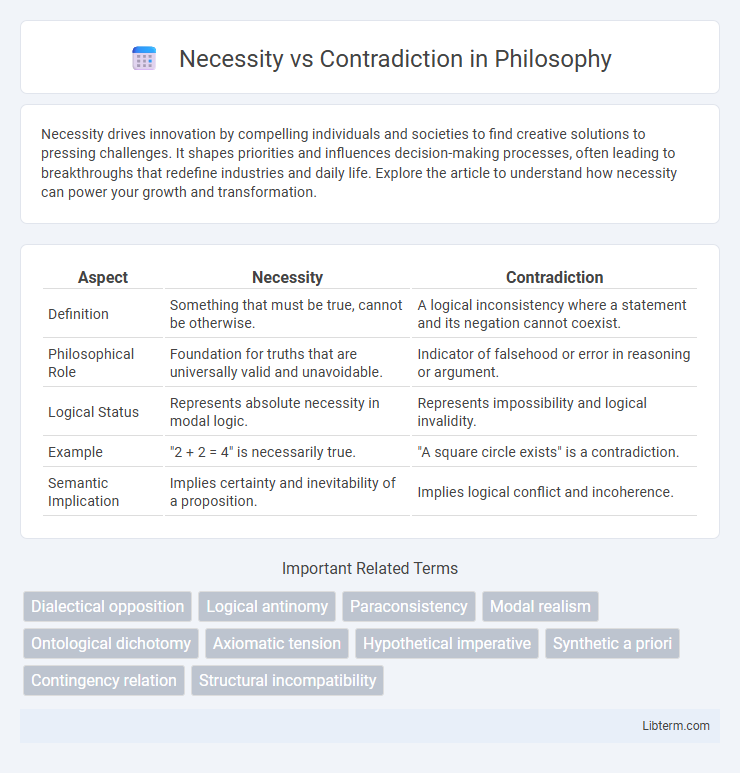Necessity drives innovation by compelling individuals and societies to find creative solutions to pressing challenges. It shapes priorities and influences decision-making processes, often leading to breakthroughs that redefine industries and daily life. Explore the article to understand how necessity can power your growth and transformation.
Table of Comparison
| Aspect | Necessity | Contradiction |
|---|---|---|
| Definition | Something that must be true, cannot be otherwise. | A logical inconsistency where a statement and its negation cannot coexist. |
| Philosophical Role | Foundation for truths that are universally valid and unavoidable. | Indicator of falsehood or error in reasoning or argument. |
| Logical Status | Represents absolute necessity in modal logic. | Represents impossibility and logical invalidity. |
| Example | "2 + 2 = 4" is necessarily true. | "A square circle exists" is a contradiction. |
| Semantic Implication | Implies certainty and inevitability of a proposition. | Implies logical conflict and incoherence. |
Understanding Necessity: Defining the Concept
Necessity refers to conditions or propositions that must be true in all possible situations, indicating an inherent or logical inevitability. It is defined by the impossibility of its negation without causing a contradiction, often explored in modal logic to distinguish it from contingency and impossibility. Understanding necessity requires recognizing its role in establishing truths that hold universally across all conceivable worlds or scenarios.
Contradiction Unveiled: Meaning and Impact
Contradiction unveiled reveals opposing ideas or statements that cannot coexist, highlighting logical inconsistencies within arguments or beliefs. This fundamental discord challenges assumptions, prompting critical analysis and deeper understanding of complex concepts. Recognizing contradictions drives intellectual growth and refines decision-making processes by exposing flawed reasoning.
Historical Perspectives on Necessity and Contradiction
Historical perspectives on necessity and contradiction trace back to ancient Greek philosophy, where Aristotle defined necessity as an unalterable fact, while contradictions were viewed as logical impossibilities within his law of non-contradiction. Hegelian dialectics advanced this view by suggesting that contradictions are inherent in reality and drive historical progress through synthesis, integrating opposing forces into necessary development. Marxist theory later emphasized contradictions within social and economic structures as the engine of historical change, positing that material conditions inevitably lead to revolutionary transformations.
Necessity in Logic and Philosophy
Necessity in logic and philosophy refers to propositions or truths that cannot be otherwise and must hold under all possible circumstances. It contrasts with contingency, where statements are true in some situations but not others, emphasizing the foundational role of necessary truths in modal logic and metaphysical frameworks. Understanding necessity aids in distinguishing valid arguments and exploring the nature of existence, causality, and knowledge.
Contradiction as a Catalyst for Change
Contradiction acts as a catalyst for change by exposing inconsistencies within existing systems, prompting critical reassessment and innovation. Conflicts between opposing ideas drive transformation in philosophy, science, and society by challenging assumptions and fostering dynamic progress. This tension between necessity and contradiction fuels evolution, enabling breakthroughs that rigid adherence to necessity alone might stifle.
Balancing Necessity and Contradiction in Decision-Making
Balancing necessity and contradiction in decision-making requires recognizing essential factors while critically evaluating opposing viewpoints to avoid cognitive biases. Effective leaders weigh the imperative actions against contradictory evidence to create well-rounded strategies that address uncertainties. Incorporating diverse perspectives ensures that necessity drives progress without dismissing valuable challenges that improve outcomes.
Real-World Examples: When Necessity Meets Contradiction
In urban planning, the necessity of expanding infrastructure to accommodate growing populations often contradicts environmental preservation goals, exemplified by projects like highway construction through protected forests. In healthcare, the imperative to deploy rapid diagnostic tests during pandemics clashes with accuracy concerns, highlighting the tension between urgent necessity and potential contradictions in reliability. Renewable energy initiatives illustrate necessity versus contradiction when solar farms require vast land, conflicting with agricultural land use priorities.
Resolving Contradictions: Strategies and Solutions
Resolving contradictions involves identifying conflicting elements and applying strategies such as compromise, reframing, or synthesis to achieve coherence. Techniques like dialectical thinking, root cause analysis, and integrative negotiation facilitate effective contradiction resolution in complex systems or debates. Implementing these solutions enhances decision-making, innovation, and conflict management across disciplines.
Necessity vs Contradiction in Modern Society
Necessity and contradiction shape modern society by driving progress and innovation through the resolution of conflicting needs and ideas. Economic growth depends on balancing essential resource demands with social contradictions like inequality and environmental challenges. Technological advancements emerge as solutions to these contradictions, highlighting the dynamic interplay between what society requires and the obstacles it faces.
Future Implications: Embracing Both in a Dynamic World
Understanding the interplay between necessity and contradiction is crucial for navigating future challenges, as necessity drives essential actions while contradictions highlight tensions that foster innovation. Embracing both concepts enables adaptive strategies that balance stability with transformative change, ensuring resilience in unpredictable environments. This dynamic approach cultivates progress by integrating foundational needs with evolving complexities in a rapidly shifting global landscape.
Necessity Infographic

 libterm.com
libterm.com